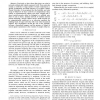Free Online Productivity Tools
i2Speak
i2Symbol
i2OCR
iTex2Img
iWeb2Print
iWeb2Shot
i2Type
iPdf2Split
iPdf2Merge
i2Bopomofo
i2Arabic
i2Style
i2Image
i2PDF
iLatex2Rtf
Sci2ools
IJCNN
2006
IEEE
2006
IEEE
A Very Small Chaotic Neural Net
— Previously we have shown that chaos can arise in networks of physically realistic neurons [1], [2]. Those networks contain a moderate to large number of units connected in a spatial arrangement providing instances of so-called Cellular Neural Networks. It was proposed that the flexibility and wide range of behaviors of chaos could be of computational value, namely in spatiotemporal regimes and when coupled with a chaos control process, either in biological or artificial nets. Here we aim to find a minimal network of realistic neurons already featuring a chaotic regime. Such a small network can be computationally useful per se, or otherwise constitute the building block of larger networks with even richer dynamical regimes. Our investigation unveils the role of the interplay between a homoclinic tangency and the presence of delays in neural signal transmission in the creation of complex behavior.
| Added | 11 Jun 2010 |
| Updated | 11 Jun 2010 |
| Type | Conference |
| Year | 2006 |
| Where | IJCNN |
| Authors | Carlos Lourenco |
Comments (0)

